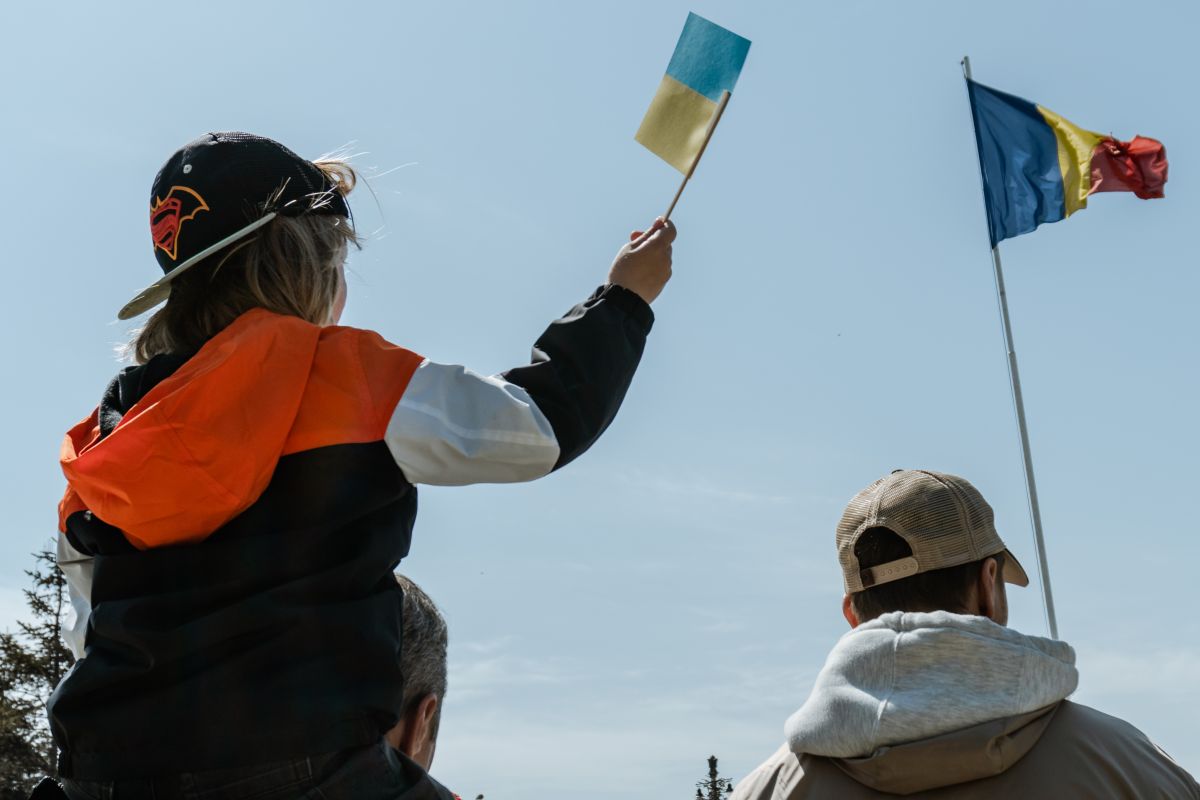Romania's Support for Ukraine Clear but Restrained
Although Romania is among the countries of NATO’s Eastern Flank most fearful of Russian aggression, it pursues a policy of wait and see on the war in Ukraine. It supports the latter politically but has given only symbolic military aid. It is in Poland’s interest to persuade Romania to increase its support for Ukraine to help it fight off the Russian aggression, which could also contribute to a lasting increase in trust between Poland and Romania that in turn could foster post-war cooperation in the region.
 Gheonea Anca/ABACA/Abaca Press/Forum
Gheonea Anca/ABACA/Abaca Press/Forum
Romanian-Ukrainian relations are burdened with historical events. They were not overcome by the 1997 treaty on good neighbourliness and cooperation, which settled territorial disputes by declaring northern Bukovina part of Ukraine and the part of Bessarabia lost as a result of the Molotov-Ribbentrop Pact as Romanian land. The mistrust was deepened by a dispute over the division of territory on the Black Sea shelf, adjudicated by the ICJ in 2009 that granted 79% of the disputed area to Romania. Another conflict is the border demarcation in the Danube Delta, in particular the Bystroye canal built there by Ukraine, which according to the Romanian authorities threatens a UNESCO nature reserve.
A period of rapprochement between Ukraine and Romania triggered by the Russian aggression in 2014 in Crimea and Donbas collapsed in 2017 when Romanian President Klaus Iohannis cancelled his visit to Kyiv in protest of a new education law. Romania accused Ukraine of not respecting minority rights. According to the 2001 census, 151,000 Romanians and 259,000 Moldovans, considered compatriots, live in Ukraine. Despite this disagreement, Romania refrained from similar actions as Hungary, which blocked NATO cooperation with Ukraine, wanting to force it to concessions on the issue of minority rights.
Political and Military Support
In the face of the new invasion, Romania declared political support for Ukraine, but has been restrained in expressing it. Prime Minister Nicolae Ciucă did not visit Kyiv until 26 April, weeks after the city was visited by numerous European leaders, including the prime minister of the distant Spain. Iohannis waited until 16 June to visit the city, joining the leaders of France, Germany, and Italy, although regional presidents—Poland, Lithuania, Latvia, and Estonia, the EU and NATO countries with the most similar security perception as Romania—visited the Ukrainian capital on 13 April.
At the same time, Romania strongly condemns the Russian aggression. It supported Ukraine before the ICJ, accusing Russia of falsely invoking an alleged genocide by Ukraine in Donbas to justify the invasion. Romania co-initiated the UN Human Rights Council resolution condemning Russian war crimes. It also supported a motion in the ICC to prosecute Russia and transferred €100,000 to support f the ICC prosecutor’s actions. Romania backs giving EU membership candidate status to Ukraine. Admittedly, Iohannis was not a signatory to a February letter by the presidents of Central European states on this issue, but he supported it, extending it to Moldova.
Romania allows the transit of weapons from the U.S. but has provided Ukraine with only symbolic military aid. At the end of February, it shipped 2,000 helmets and body armour, fuel, ammunition, and dressings worth a combined €3 million. Additional support probably has been minimal. The Romanian authorities refuse to provide information about their contributions on the grounds of security, although even Slovakia and Greece, which are traditionally sympathetic to Russia, have openly provided substantial aid to Ukraine. Unofficially, Romania explains its attitude with its own deficiencies. This is indirectly confirmed by Ukraine, which emphasises the partner’s reliability and does not insist on more help from it. Ukraine probably wants to maintain correct relations with it because it counts on Romanian support on other issues. Romania has accepted about a million war refugees, and several tens of thousands remain. It also opened a logistic centre in Suceava for foreign humanitarian aid to Ukraine and made its ports available for Ukrainian trade.
Export of Ukrainian Grain
Romania is helping Ukraine, whose ports are blocked by Russia, to export grain. Ukraine’s current export needs are around 18 million tonnes. In 2021, the main Romanian port in Constanţa transhipped about 25 million tonnes of domestic grain and grain from Hungary and Austria. To increase its capacity, the government simplified procedures and provided €40 million for emergency repairs. However, the challenge is the lack of rolling stock and cross-border connections. On the way to Constanţa, grain has to be reloaded from railway cars to barges in Reni or Izmail, Ukrainian ports on the Danube. This process is only slightly improved by the reconstructed broad-gauge railway from Moldova to the Romanian Danube port in Galaţi. That is why Romania is striving at the EU forum for river and railway rolling stock for transporting grain, as well as for the possibility of using cohesion funds to build silos and trans-shipment equipment. To ease barge congestion, Romania has suspended its protest against shipping on the Bystroye canal. It also agreed to third-country vessels sailing to and from Reni or Izmail on the Chilia border portion of the Danube. It will lose payments from navigation pilotage, as until now only the Sulina arm—entirely Romanian—was available to such vessels.
Romania is describing itself as a leader in countering the risk of famine around the world caused by the shortage of grain from Ukraine. Iohannis emphasised this role in a meeting with French President Emmanuel Macron in June. It was also confirmed by Romania’s participation at the invitation of the U.S. in a Security Council debate and UN ministerial meeting on food security. Probably to strengthen this position, the foreign minister overstated the effects of Romania’s help, claiming in July that thanks to it Ukraine had exported 2.7 million tonnes, about half of its total grain exports, when in fact only 1 million tonnes were shipped via Constanţa. The German foreign minister estimated in July in Bucharest that Romania’s potential for transferring grain on the Danube and through this port was 2 million tonnes till the end of this year.
Romanian Perception of Security
Romania is trying to keep the hostilities away from its coastal territory. It was especially concerned about the capture of Snake Island by Russia, as it is located only about 40 km from the Danube delta and borders the gas-rich Romanian sea shelf. Other threats to shipping and its ports include drifting mines and mistaken attacks on neutral ships—Russia has already twice damaged the Moldovan chemical tanker Millennial Spirit. Iohannis, while in Kyiv, called for the formation of a coalition that would secure shipping lanes for vessels with Ukrainian grain. However, Romania is sceptical of Türkiye-Russia agreements that sanction the continued presence of the Russian fleet near the Romanian coast. It prefers France’s proposal to export grain via the Danube and by the port of Constanţa. Romania counts on it not only for economic growth but also because it is strategically important. This was confirmed by the Deputy Prime Minister and Minister of Transport Sorin Grindeanu, who indicated that this port may become the most important one in the Black Sea, although it requires the acceleration of the construction of the Via Carpatia highway and the Rail2Sea railroad, routes through which allied assistance could come to Romania in the case of a blockade of sea routes.
In the face of the war in Ukraine, Romania has gained a strengthened allied presence on its territory. NATO this year established a battalion battlegroup that Romanian diplomacy had been seeking since 2015, and the U.S. increased its contingent from 900 to 2,000 troops. At the summit in Madrid in June 2022, the Alliance decided to expand the unit to brigade level; now there are 550 soldiers from France, 250 from Belgium, 230 from Poland, and 120 from the U.S. The United States also will send an additional brigade, which will raise its forces in Romania to 7,000 soldiers.
Conclusions
Romania has been restrained in helping Ukraine despite being an allied flank state that sees the threat from Russia, condemns its aggressive actions, and supports sanctions against it. The war has not overcome the passivity in relations with Ukraine resulting from deep distrust. Romania’s attitude is fostered by the ambiguous policies of Germany and France, its most important partners in the EU. Romania, though, has accepted substantial numbers of war refugees and provides international humanitarian aid, but has provided only symbolic quantities of weapons and war materiel. It could, for example, deliver ammunition in Soviet calibres for artillery in the 122 mm and 152 mm sizes, or for spare parts even T-72 tanks and MiG-29 fighters that are in storage .
Romania helps Ukraine export grain. Although transit via the port of Constanţa remains small, Romania is hyping it for self-promotion purposes in the countries receiving the grain. This is particularly important for its image in Muslim countries, tarnished in 2018 by the announcement that the embassy in Israel would be moved from Tel Aviv to Jerusalem. These countries’ support may determine the success of the Romanian candidacy to the UN Human Rights Council for the 2023-2025 term.
For Romania, it is important still to argue against initiatives involving Ukraine if they appear to be at the expense of Moldova, with which Romania maintains special relations. That is why Poland, striving for wider Romanian support for Ukraine, could offer cooperation in the modernisation of the Moldovan army to make it able to face potential Russian aggression. The two governments can also coordinate on efforts to increase EU logistical and financial support for the export of Ukrainian grain.


